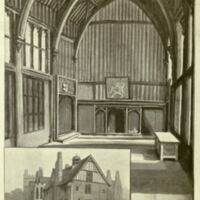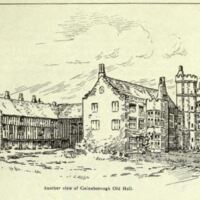Subject
The first port of call for Homes and Haunts of the Pilgrim Fathers is Gainsborough Old Hall. An important site on the Mayflower tourist trail since Bartlett’s guide in the 1850s, MacKennal provides a summary of the building’s history that incorporates writing by George Eliot and local historian Adam Stark (1784–1867):
"There is in Gainsborough one noble relic of antiquity the manor-house; or, as it is now called, the Old Hall. George Eliot describes this too, with accuracy of observation and sympathetic insight: 'It was the Normans who began to build that fine old hall, which is like the town, telling of the thoughts and hands of widely sundered generations; but it is all so old that I’ve look with loving pardon at its inconsistencies, and are well content that they who built the stone oriel, and they who built the Gothic facade and towers of finest small brickwork with the trefoil ornament, and the windows and battlements defined with stone, did not sacrilegiously pull down the ancient half-timbered body with its oak- roofed banqueting hall.'
In Stark's History of Gainsborough we have a more careful architectural account of the erection:' The front of the Old Hall is principally constructed of large oak timber framing, forming three sides of a quadrangle, open to the south; but the back part of the building is generally of brickwork.' On the north side there is part of a very beautiful pointed stone structure, which probably was originally intended for a chapel. This chapel was probably executed by Richard de Gaynisburgh, a distinguished mason, who flourished about the end of the fourteenth century, and was much employed in repairing and beautifying the cathedral at Lincoln, in the east end of which he was buried.' Sir Thomas Burgh, temp. Henry VI. and Edward IV., appears to have bestowed considerable pains in re-building the Manor House, as the greater part of it seems to be of the style of architecture then beginning to be in use. The tower, at the north-west end, about eight}- feet in height, is built entirely of brick, and finished in a most masterly manner, the bricks being all well smoothed and excellently joined. The trefoil ornament is here very conspicuous; and the whole bears evident marks of the utmost care and attention having been bestowed upon it.'
We owe very much to these restorers and beautifiers of the older time; we recognise how much we owe them when we see what destruction the architectural self-consciousness of our own century works on the remains of antiquity. The plasterers and whitewashes of the Georgian period covered up much beautiful building, but at least they left it for us to unveil; many of our recent enthusiasts have destroyed precious work for the sake of uniformity in style. In this Old Hall of Gainsborough, timber and brick and stone, Gothic and Tudor and English domestic work, blend in an exquisite harmony, as gratifying to the eye as it is full of historical suggestion."
This combination of literary description, historical accounts, and conjecture is common in popular Mayflower tourist literature. The lack of detailed historical records of the lives of the Brownist seperatists almost demands such as approach. These texts are also significant historical records themselves, revealing contemporary attitudes to local towns and landmarks. For instance Mackennel at pains to note what he sees as the insalubrious prospect afforded to the rail traveller approaching Gainsborough in the late nineteenth-century:
Yes; Gainsborough is […] picturesque, dreamy, quaint; but not as you come to it by rail. Then you see the smoke, and hear the din of driving wheels and revolving shafts and clashing doors; and your eyes are blinded to the past, and your ears do not take in the silence of bygone centuries. Gainsborough is three towns in one. From the market-place, which unites them all, the town expands to the railway, concentrates itself toward the river, and along the roads, where the neat villas of the prosperous tradesmen are, it steps out leisurely into the country. It is a curious, even a mysterious, town; not striking, but interesting, with an interest which grows; in the general absence of buildings of monumental antiquity, you wonder that it should look so old; you search for beauty, which you do not discover, and your eye is caught by some bit of domestic picturesqueness or venerable age. There are soft, low hills about it, with the shadow of trees, and green patches that look up meekly through the smoky air.



